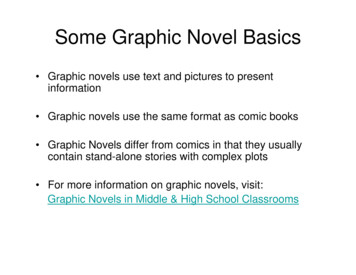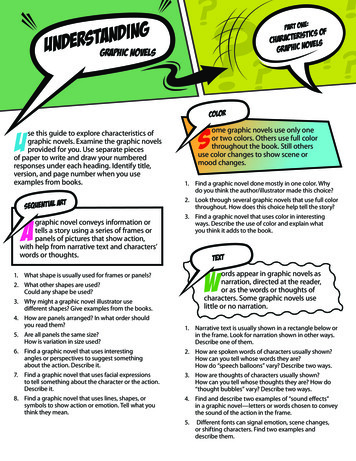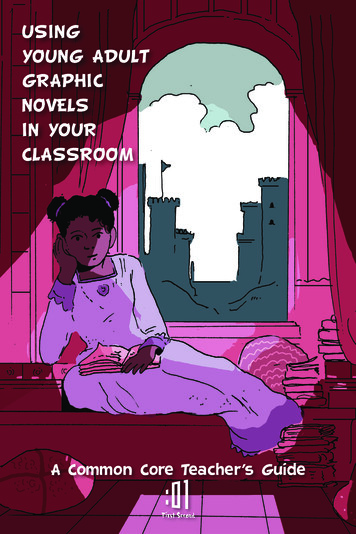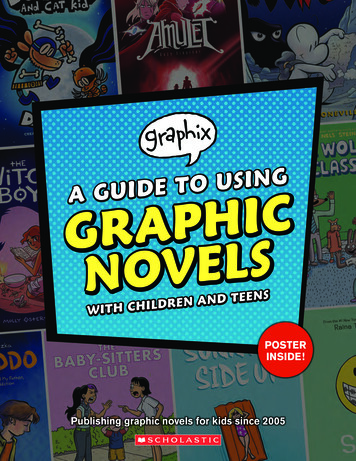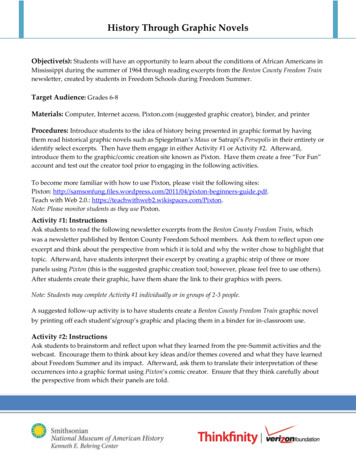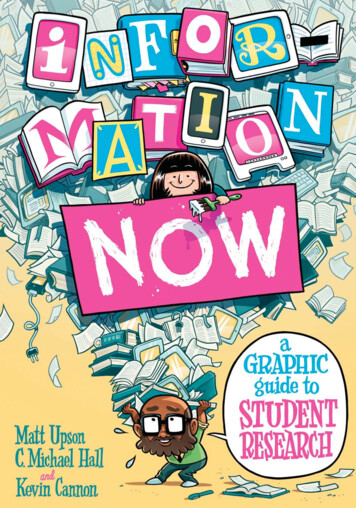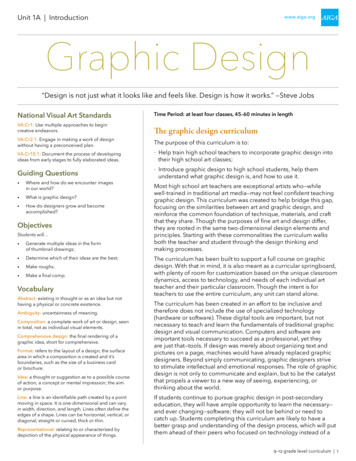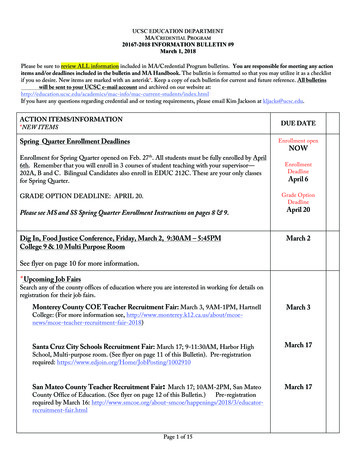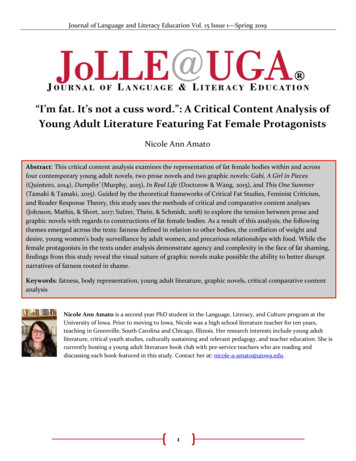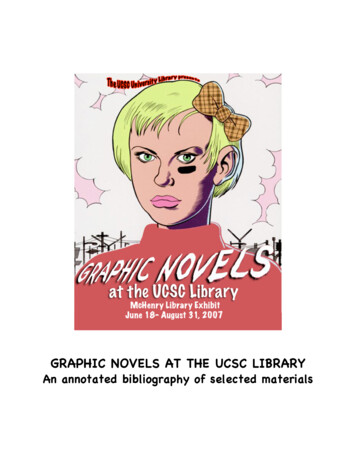
Transcription
GRAPHIC NOVELS AT THE UCSC LIBRARYAn annotated bibliography of selected materials
Graphic Novels at the UCSC LibraryAn annotated bibliography of selected materialsThe sophistication of the American comic book/graphic novel field may be themost underrated literacy movement in recent United States history. It is withinthe graphic novel format that one encounters much of the most experimental andexciting work being done in the comics medium today.(1) Graphic novels are nowregularly being reviewed in The New York Times Book Review. Museums areacquiring pages of comic art. Esquire and The New Yorker have run comic storiesin their fiction issues. A MacArthur grant was awarded to a cartoonist. Whetherone considers graphic novels as art or as literature, it is becoming apparent thatthis medium, after a prolonged adolescence, is coming of age.(2)(1) Steven Weiner "100 Graphic Novels for Public Libraries" Kitchen Sink Press, 1996(2) The National Association of Comics Art Educators)(1999) 300. Story & art, Frank Miller ; colors, Lynn Varley. Milwaukie, Or. : Dark HorseComics.McH StacksPN6727.M55 A2 1999From Publishers WeeklyThe Battle of Thermopylae ranks as one of the ancient world's most important events, whereSpartan King Leonidas and his 300-man bodyguard met the massive army of Emperor Xerxes ofPersia, who intended to add Greece to his empire. To no one's surprise, the Spartans weredestroyed. While the battle bought the Greeks enough time to defeat the mighty Persians, it wasmore important for the metaphor it created: occasionally one has to lose to win. This is clearly theinspiration behind Miller's attempt to place this epic tale in the context of a graphic novel. Arenowned comics artist and writer known for hard-boiled stories of almost operatic intensity andstylishly overwrought violence, Miller (Sin City) injects his own brand of graphic sensationalisminto this ancient tale of national survival.(1999). Comixbykidz. Santa Cruz, Calif., Children's Art Center.Anderson, B. E., B. Costa, et al. (2001). The song of Mykal. Santa Cruz, Calif., AtlantisFantasyworld.Spec CollPN6727 .S66 2001Atlantis Fantasyworld celebrates it's 25th Anniversary in Comic Book Retailing by producing it'sown comicAoyagi, N. (2005). A case of the racing spill bunnies : a story. Santa Cruz, N. Aoyagi.Spec CollPN6727.A599 C37 2005Book DescriptionA tale of a girl and her monsters.Barry, L. (2000). The greatest of Marlys. Seattle Wash., Sasquatch Books.McH StacksPN6727.B36 G74 2000From Publishers WeeklyCharmingly illustrated and written in the voices of fictional preadolescents, Barry's comics (TheFreddie Stories) alternate between delightful comedy and un-self-conscious poetry. Her comicscatalogue the incremental maturation of the smart but unpopular preteen Marlys; her painfullysensitive little brother, Freddie; her big sister, Maybonne; her cousins Arna and Arnold; andoccasionally the various adults in their lives. The book collects more than 200 of her syndicatedfour-panel strip Ernie Pook's Comeek, in which Barry deftly maps the emotional terrain of Marlysand the inevitable social traumas inherent in growing up.2
Graphic Novels at the UCSC LibraryAn annotated bibliography of selected materialsBarry, L. (2002). One hundred demons. Seattle S.l., Sasquatch Books ; Distributed byPublishers Group West.McH StacksPN6727.B36 O54 2002From Publishers WeeklyAs anyone who's read her comic strip Ernie Pook's Comeek or novel Cruddy knows, Barry has apitch-perfect sense of the way kids talk and think. Childhood's cruelties and pleasures,remembered in luminous, unsparing detail, have become the central topic of her work. The semiautobiographical vignettes of this new work, originally serialized in Salon, follow the same basicformat as the strip: blocks of enthusiastic first-person commentary at the top of each panel,squiggly, childlike-but stylized-drawings and dizzy word-balloon dialogue between thecharacters. Here, though, Barry gets a chance to stretch out, drawing out her memories andimpressions into long, lively, sometimes sweet and sometimes painful narrative sequences on aseemingly endless list of curiously compelling topics: the scents of people's houses (one is "acombination of mint, tangerines, and library books"), dropping acid at 16 with a grocery bagger,the colors of head lice and the art of domesticating abused shelter dogs.Baru and J.-M. ThÈvenet (2002). Road to America. Montreal, Drawn and Quarterly.McH StacksPQ2662.A747 R63 2002From Publishers WeeklySet mainly in late 1950s Algeria and France during Algeria's war of independence, this work tellsof young, working-class Algerian Said Boudiaf, whose first offer to box professionally comes ascar bombs explode in the street nearby. His brother joins the resistance against the French, whileSaid leaves for France to fight professionally. When Said arrives in the Paris train station, agendarme hits him and calls him a "dirty Arab" before the apologetic French Minister of Sportsgreets him. Fighting his way to the championship, Said avoids taking sides in the conflict,convinced sport is beyond politics. The French government and the Algerian resistance use Saidas a propaganda tool, but Said only wants to box. Agents of the Algerian National LiberationArmy trail him, threatening his life, and when Said wins the French Boxing Championship, thecrowd erupts in rioting, French against Algerian. Said makes it to America and qualifies to fightfor the world title, but when he returns to Paris during the intervening months before his titlefight, he's caught up in the turmoil of October 17, 1961, the day thousands marched in Paris'sstreets to protest curfews against Algerians and faced violent repression by policeBechdel, A. (2003). Dykes and sundry other carbon-based life-forms to watch out for. LosAngeles, Alyson Books.McH StacksPN6728.D94 B46 2003From Publishers WeeklyThat sprawling crew of feisty counter- and not-so-counter-culturalists are back in a 20thanniversary collection of Bechdel's popular lesbian-themed strip. Devoted readers may be happyto find some things never change: Mo is still a social malcontent, and her colleague, Lois, is asrebellious as ever. (This time, she's tweaking Mo by pretending to consider becoming a man.) Thebookstore where they work has its usual financial difficulties, and everyone still hates thepresident. But not all is as it once was. For one thing, same-sex marriages (well, unions) are nowlegal in Vermont, and one couple, Clarice and Toni, consider whether to make their relationshipofficial in the state's eyes. Then there's Sparrow: a long-time member of the group house whereLois lives, who has fallen in love with another housemate-a man-and seems to be unexpectedlypregnant. And Ginger, an academic, is facing the purgatory of a non-tenured position at anundistinguished school; buried under papers to grade, she barely even notices when a lovelywaitress at a local juice bar makes a move.Bell, R. and M. Sinclair (2005). Pictures and words : new comic art and narrative illustration.London, Laurence King.McH StacksPN6710 .B45 2005Book descriptionThis delightful book explores the various uses of images with and without text in the work ofover thirty artists from around the world. From the delicate illustrations of Marcel Dzama to thestylized strokes of Simone Lia, the politically charged works of Joe Sacco, and the psychological3
Graphic Novels at the UCSC LibraryAn annotated bibliography of selected materialsmystery of Andrejz Kilmowski’s The Secret, contemporary comic art spans a vast spectrum ofstyles and subjects. Pictures and Words examines the range of descriptive possibilities withinnarrative illustration and showcases outstanding works by artists from sixteen differentcountries—artists whose creations represent the best and most original current work in thisincreasingly popular genre.Bergeron, B. (1973). Prairie State blues. Chicago, Chicago Review Press Book.Spec CollPN6727.B4P7Boxer, S. (2001). In the Floyd archives : a psycho-bestiary. New York, Pantheon Books.McH StacksPN6727.B685 I52 2001From Publishers WeeklyRemember when dogs were not allowed on the furniture? Well, here a near-menagerie ends upon the couch with hilarious results that also lead to some sharp insights into human behavior.Part critical gloss on actual Freudian case histories, part postmodern humor and partly a veryfunny and silly series of cartoon strips (drawn by the author) of a week by week psychoanalysisof multiple characters, the book ends up as an oddly moving graphic account of the nature ofhuman obsession, fear, longing, rage and terror. Mr. Bunnyman comes to Dr. Floyd because he isbeing chased by a wolf. The strictly Freudian doc understands that this is a paranoid fantasy, buthas no problem devoting a separate 50 minutes to the Wolf, because the Wolfman has an alterego, Lambskin, who wants attention as well. Before you know it, the obsessive-compulsiveRatma'am also joins the zoological roster of clients.Briggs, R. (1998). Ethel & Ernest. London, J. Cape.(2002)McH StacksPR6052.R4434 E8 1998Book DescriptionPoignant, funny, and utterly original, Ethel & Ernest is Raymond Briggs's loving depiction of hisparents' lives from their chance first encounter in the 1920s until their deaths in the 1970s. Etheland Ernest were solid members of the English working class, part of the generation that livedthrough the most tumultuous years of the twentieth century. They met during the Depression-she working as a maid, he as a milkman--and we follow them as they court and marry, make ahome, raise their son, and cope with the dark days of World War II. Briggs's portrayal of how hisparents succeeded, or failed, in coming to terms with the events of their rapidly shifting world-the advent of radio, television, and telephones; the development of the atomic bomb; the moonlanding; the social and political turmoil of the sixties--is irresistibly engaging, full of sympathyand affection, yet clear-eyed and unsentimental.Bukowski, C. and R. Crumb (1984). There's no business. Santa Barbara, Black Sparrow Press.McH StacksPS3552.U4T48 1984Camper, J. (1999). Subgurlz. San Francisco, Calif., Cleis Press.McH StacksPN6727.C36 S83 1999Book DescriptionSet in the toxic labyrinth of abandoned subway tunnels, SUBGurlz chronicles the superherohappenings of three chemically altered girlfriends. Swizzle is the strongest person on earth unfortunately, the poor thing's always killing people accidentally. Liver, her girlfriend, is blessedwith the power to bring back the dead. Byte has brainpower so stupendous that she's unable togrow hair on her head. Are the SUBGurlz good or bad? It all depends on which side you're on.(2000). Le Centre belge de la bande dessinÈe. Tournai, Renaissance du livre.McH StacksPN6705.B4 C45 2000Publication of The Belgian Centre of Comic Strip Art.4
Graphic Novels at the UCSC LibraryAn annotated bibliography of selected materials(2006). Chimurenga. 9, Conversations in Luanda and other graphic stories. Cape Town, PanAfrican Market.McH StacksNC1740.S6 C45 2006From publication wesiteChimurenga, a publication, of arts, culture and politics from and about Africa and its Diasporas,has been in print since March 2002. This issue of Chimurenga Comics has a thematic coherence inits insistence on art as interrogator and creator.Clamp (2002). Chobits. 3. Los Angeles, CA, Tokyopop.McH StacksNC1709.C53 C43 2002From Publishers WeeklyClamp is an all-female manga-creating team whose feminine touch shows in this entertaining,sci-fi soap opera. Besides a plot revolving around personal drama, the art style borrows from theJapanese romance genre, where girls have huge doe eyes and long, flowing hair, and fuzzy, floridbackdrops frame sentimental moments. Clamp excels at multiple manga styles, transitioningthrough realistic establishment panels of urban scenes, the cartoony explosions of facialexpressions in comedic moments and science fiction and romance. Presenting the work inoriginal right-to-left format, TokyoPop has also left in the Japanese sound effects that are integralto the art, carefully embedding drawn-to-match English translations within the frame.Clowes, D. (2001). Ghost world. Seattle, WA, Fantagraphics.McH StacksPN6727.C565 G6 2001From School Library JournalEight interconnected stories about two teens. Enid and Rebecca have been friends for so long thatit's difficult for either of them to let the other grow or change. Now Enid will probably leave theirworking-class neighborhood and go away to college and Rebecca cannot accept this change intheir relationship. Enid is the more radical and dramatic of the two, the one who talks a malefriend into escorting her into an X-rated "adult" store. Rebecca is not so much a follower assimply more circumspect. She's the one who reasons that Josh, a friend they're both guilty ofprovoking sexually, really deserves to sleep with one of them after all the teasing he's weathered.While the vocabulary here is raunchy, it is accurate for the characters. These realistic 18-year-oldsdon't always talk nice and don't always act nice but they do have moral fiber underneath theirtough-girl exteriors. It's just that they're at a point in life and a place in society where exteriors area lot more important than nice.Clowes, D. (2005). Ice haven. New York, Pantheon Books.McH StacksPN6727.C565 I33 2005From Publishers WeeklyClowes (Ghost World) casts a harsh spotlight on the misfit dreamers who inhabit the small town ofIce Havenin this riveting graphic novel. Originally published in a somewhat different form aspart of Clowes's occasional comic book Eightball, this piecefinds Clowes moving beyond thewithering satire of his earlier works to a more nuanced style. Readers will wince even as they feelsympathy for the self-deluded characters who reside in Ice Haven. Take narrator RandomWilder, writer of doggerel poetry. One would think it'd be easy to be the best poet in a place likeIce Haven, but Wilder has a rival: Ida Wentz, an old woman who likes to bake cookies. Wilderspends his spare time plotting against her. Ida's visiting granddaughter, Vida, also has literaryyearnings, despite having sold zero copies of her fanzine. These and other oddballs play out theirstories against the mysterious disappearance of a little boy named David Goldberg, whosepossible murder recalls the Leopold and Loeb case. Clowes unfolds the multifaceted story as aseries of brief comics, some drawn in a wildly cartoony style, others in his well-known mid–20thcentury look. Masterfully blending fact and fiction, this is a funny, sad, chilling and absurd work.Crumb, R. (2001). Odds & ends. New York ; London, Bloomsbury : distributed to the trade inthe USA by St. Martin's Press.McH StacksPN6727.C7 O33 2001From Publishers Weekly5
Graphic Novels at the UCSC LibraryAn annotated bibliography of selected materialsCalled "the Brueghel of the last half of the 20th century" by no less a skeptic than establishmentart critic Robert Hughes, cartoonist R. Crumb has produced some of the smuttiest yet piercinglyaffecting and quintessentially American art since the 1960s. Fans of Mr. Natural, the MonkeyWrench Gang, Fritz the Cat, Devil Girl and Crumb's agonized self-portraits won't want to missOdds & Ends, a new, chronologically organized collection of unpublished doodles, Valentinecards drawn during his employment at American Greetings, covers for undergroundnewspapers, advertisements for porn theaters and bike shops, and record album covers. Crumbselected the myriad b&w and color drawings here, all displaying his dark and hilariousvulgarity.Crumb, R. (2002). Gotta have 'em : portraits of women. Los Angeles, Calif., Greybull Press.McH StacksPN6727.C7 G68 2002Book DescriptionFor the first time ever, his drawings of women are collected in one brilliantly offensive yethilariously poignant volume, in chronological order, spanning the 38 years since his pen-and-inkbeginnings. The usual fetishes are on display, natch--the built-from-the-ground-up body type, thelovingly fixated-upon solid thighs and buttocks--but so is Crumb's heart, on his sleeve, in thegreat tenderness with which he has rendered the women in his life. They're all here: his highschool crushes, his paramours, the girls and women who tormented him--and to whom he gave itright back--or who caught his eye on the street, and, of course, his wife and fiery sometimecollaborator, Aline, and their daughter Sophie. Crumb calls it "an autobiography of sorts" and itis--these aren't just portraits of women but the most intimate portrait of Crumb's life in love.Cruse, H. (1995). Stuck rubber baby. New York, N.Y., Paradox Press.McH StacksPN6727.C74 S86 1995Book DescriptionArt and story combine powerfully in this lyrical tale of a young man caught in the maelstrom ofthe civil rights movement and the systematic homophobia of small-town America. Told inflashback, this is the story of Toland Polk, the son of an uneducated white carpenter who hasgrown up in the Southern town of Clayfield. It is the 1960s, a time of passionate beliefs andviolent emotions, and Clayfield's citizens are divided in the fight over segregation. As Tolandfights on the side of the civil rights activists, he slowly begins to realize and try to deny that he isgay. With a subtle yet intricate plot, and distinctively evocative illustrations, Stuck Rubber Babyis an unflinchingly honest look at one man's world of fears, dreams and prejudiceDelany, S. R. and M. Wolff (1999). Bread & wine : an erotic tale of New York. New York City,Juno Books.McH StacksPN6727.D38 B74 1999From Publishers WeeklyUnusually touching, this comics memoir presents the beginnings of an unlikely but lovingrelationship between Delany (Times Square Red, Forecasts, May 31), a distinguished AfricanAmerican novelist, essayist and professor, and Dennis, a white homeless man barely scraping byon the streets of Manhattan. Delany first notices Dennis, grime-covered and clad in filthy clothes,around his Upper West Side neighborhood selling used books on the street, his possessionspacked in a shopping cart. But beneath the dirt and stink, Dennis is funny, honest andcaringAand, like Delany, he is gay. Before long, Delany invites him to share a motel room andthen (after much consideration by both of them) to visit him in Massachusetts, where Delanyteaches.DiMassa, D. (1999). The complete hothead paisan : homicidal lesbian terrorist. San Francisco,Calif., Cleis Press.McH StacksPN6727.D56 C66 1999Amazon.comCan't get enough man-slashing, het-hating action? Check out this dangerous volume, whichbrings together two earlier collections of the adventures of Diane DiMassa's popular independentcomic. Join coffee-addicted lesbian terrorist Hothead Paisan on her restful vacation inProvincetown, and learn how she deals with gawking straight couples. Watch her surgical6
Graphic Novels at the UCSC LibraryAn annotated bibliography of selected materialsassault on scary male doctors. Admire her preventive treatment of rapists. Hothead Paisan goeswhere the rest of us only dream of going: "Sentenced to life in a rich white banker's scrotal sack,"she takes revenge on the gapers and gropers of the city streets, offering her potent "Blow-YouAway Job" in the form of grenade, gun, and Lysol attacks. But she has a softer side, too, as shownin her devotion to her cat, Chicken, and her wise old grandmother.Eagan, T. (1985). The lost condiment of Atlantis. Santa Cruz, CA, All-night Comics.Spec CollPN6727.E33T5Eagan, T. (1982). Tim Eagan Productions presents the Fourth of July massacre. Santa Cruz, CA.,All-Night Comics.Spec CollPN6727.E33T5Eagan, T. (1990). The collected subconscious : an anthology of subconscious comics. SantaCruz, Calif., Gray Matter Press.Spec CollPN6727.A599 C37 2005Eisner, W. (2006). Comics & sequential art. Tamarac, Fla., Poorhouse Press.McH StacksNC1764 .E47 2006Book DescriptionLegendary comics creator Will Eisner turns a fine eye toward the principles of graphicstorytelling in this extraordinary work, based on his popular Sequential Art course at New York'sSchool of Visual Art. Readers will learn the basic anatomy of sequential art, the fundamentals ofcrafting stories, and how the medium works as a means of expression--a literary form that usesthe arrangement of images and words to narrate a story or dramatize an idea. Eisner has createdthe most insightful and dynamic examination of the comic art form to date. It's perfect for use bythe serious student, practicing professional and curious comic fan. The accumulation of ideas,theories and advice culled from his more than sixty years of experience is stunning to behold.Eisner, W., W. Eisner, et al. (2006). The contract with God trilogy : life on Dropsie Avenue.New York, W.W. Norton.McH StacksPN6727.E4 A6 2006From Publishers WeeklyFamed innovator Eisner showed the creators of modern comics what a potentially rich mediumthey were working with. In particular, he used the term "graphic novel" to sell A Contract withGod (1978), a collection of interrelated comics stories about residents in a Jewish tenement sectionof New York. He returned to that territory in A Life Force (1988), showing one man's uncertainprogress, and in Dropsie Avenue (1995), an historical panorama of the whole neighborhood.Printed together for the first time in this volume, the works reinforce each other beautifully.Eisner's virtuoso art always has been admired, but his writing sometimes has been disparaged asthin and sentimental. Over the span of these three books, though, emotions jostle and balanceeach other; sometimes the stories seem upbeat, sometimes fatalistic. The characters frequently aredefeated in the short term but always yearning for more than their surroundings offer. In anycase, Eisner's illustrations are superb: water drenches a man walking alone at night in athunderstorm; a fat housewife athletically performs a "heart attack" right after her husband hascollapsed with a real one; aerial cityscapes expand; and every possible expression flickers overthe characters' faces. This is an important, wonderful book.Fumika (2003). Encyclopaedia of mushrooms. Kawasaki City, Japan, S.E. Inc.Spec CollPN6790.J3 F86 20037
Graphic Novels at the UCSC LibraryAn annotated bibliography of selected materialsGaiman, Neil (2006) The Absolute Sandman / written by Neil Gaiman ; illustrated by SamKieth . [et al.] ; featuring characters created by Neil Gaiman, Sam Kieth and MikeDringenberg New York : DC Comics, 2006McH StacksPR6057.A319 A27 2006 v.1Book DescriptionTHE SANDMAN, written by New York Times bestselling author Neil Gaiman, was the mostacclaimed comic book title of the 1990s. A rich blend of modern myth and dark fantasy in whichcontemporary fiction, historical drama and legend are seamlessly interwoven, THE SANDMANis also widely considered one of the most original and artistically ambitious series of the modernage. By the time it concluded in 1996, it had made significant contributions to the artistic maturityof comic books and become a pop culture phenomenon in its own right.Gravett, P. (2005). Graphic novels : stories to change your life. London, Aurum.McH StacksPN6710 .G735 2005From School Library JournalThis is a wonderful primer for someone new to the genre or who is starting a graphic-novelcollection. Most of them are well known and are considered must-haves in any collection, such asAlan Moore and Dave Gibbonss Watchmen (DC Comics, 1995), Art Spiegelmans Maus (Knopf,1993), and Neil Gaimans The Sandman series (DC Comics). The rest of the book examines thosetitles and others like them, showing sample pages with directions on how to read them andpointing out themes, keywords, and special features.Hastings, J. (2001). Mad science. San Jose, CA, Amaze Ink.Spec CollPN6727.H37 M33 2001Hernandez, G. and J. Hernandez (1989). Blood of Palomar. Seattle, WA, Fantagraphics Books.McH StacksPN6727.H42 B65 1989Amazon.comReviewers have compared Gilbert Hernandez's work--set in the fictional Latin American town ofPalomar--with that of Gabriel Garcia Marquez and Robert Altman. Reading his brother Jaime'swork--most of which focuses on a group of Southern California Mexican American women--islike reading Tolstoy, if only Tolstoy had written about twenty-something punk girls. Love andRockets has certainly earned its legendary reputation among the comic-book cognoscenti, anddeserves to be read by an even wider audience. Welcome to the world of Los Bros Hernandez.Hernandez, J. (1987). Love and rockets : short stories. Westlake Village, CA, FantagraphicsBooks.McH StacksPN6727.H4L63 1987Amazon.comFifty issues--collected into 15 volumes that total 2,000 pages--the Hernandez brothers' Love andRockets is an enormous achievement that helped to create a new audience for comics. Notable fortheir strong female characters and their focus on relationships, rather than on traditional comicbook 'action', the stories collected in this volume, and the rest of the series, show how the comicformat can be used to create characters and situations as detailed and compelling as in any novel.Hernandez, J. (2004). LOCAS : the Maggie and Hopey stories. Seattle, WA, Fantagraphics.McH StacksPN6728.L62 H47 2004From Publishers WeeklyThese superb stories from the nearly 20-year run of Love and Rockets define a world of Hispanicgang warfare, '80s California, punk rock, women wrestlers and the subtle battle to stay true tooneself. Hernandez's main characters are Maggie and Hopey, two adorable lesbian rockers whostart out in a somewhat vague relationship and are then are separated by adventures both grandand demeaning. Maggie is a magnificent comics character, a tempestuous naïf who wears herheart on her sleeve when she's not throwing it at a succession of bad boys who ignore her, eventhough Hopey is secretly the love of Maggie's life. Hopey, a mohawked imp, is more opaque, asymbol of the youthful rebellion of punk rock that all the characters are trying to return to insome way, even as real life sweeps them further away from their dreams. Maggie's weight gain8
Graphic Novels at the UCSC LibraryAn annotated bibliography of selected materialsover the years sends her self-esteem on a downward spiral, while Hopey goes on an endless tourwith a band. Along the way, Hernandez gradually peels away the strip's early sci-fi trappings(dinosaurs and rocket ships) to create a devastatingly naturalistic world. Sharp b&w drawingscapture the characters in minute detail with a wide range of emotions. Finally collected into onevolume, these stories are among the greatest comics ever put to paper, and an essential piece ofthe literature of the punk movement.Kannemeyer, A. and C. Botes (2006). The big bad bitterkomix handbook. Johannesburg,Jacana.McH StacksNC1740.S6 K35 2006Book DescriptionShowcasing the brilliant and controversial existence of one of the world’s most famous political“comix” magazines, this anthology exhibits the wide range of published material includingcovers, postcards, posters, and drawings from the creators’ personal sketchbooks. The collectionis a testament to the contentious history of Bitterkomix and its attacks on the Afrikaner cultureand language, branching into its biting criticisms on South African society itself. Undeniablybrilliant and often outrageous, the art content from Bitterkomix is interspersed with essays andarticles by artists and poets, such as Antjie Krog and Ryk Hattingh. The resultant book is anessential chronicle, catalogue, and visual cornucopia of the work of the Bitterkomix artists andcreators.Katchor, B. (1996). Julius Knipl, real estate photographer. Boston, Little Brown and Co.McH StacksPN6727.K28 J48 1998From Amazon.comBen Katchor's dreamscape is peopled by transistor radio listeners, door-knob triers, false eyebrowimporters, and a late-night-perambulating real estate photographer named Julius Knipl. Thevaguely melancholy stories in his eight-panel comic strips reflect a fondness for the forgotten, theobscure, and the merely overlooked. What happens to the city's wholesale calendar salesmen inFebruary? Who buys last year's tinned seedless grapes? Katchor's shadowed line drawings of agray metropolis evoke musty smells, the shuffling steps of retirees, and a proliferating autumnalchill. Readers who enjoy his work in their local weekly papers, as well as NPR listeners who havebeen held captive by the "Knipl Radio-Cartoons" will be glad to linger a little longer in the dreamlife of Katchor's world.Katchor, B. (1998). The Jew of New York. New York, Pantheon Books.McH StacksPN6727.K28 J48 1998From Publishers WeeklyMuch as he does in his acclaimed comic strip Julius Knipl, Real Estate Photographer, Katchoruses the intricacies of urban social life to create a dense, whimsically inventive portrait-in-comicsof New York City, this time at the dawn of the capitalist age. The work opens in 1830 as the NewWorld Theater prepares its production of an anti-Semitic comedy titled The Jew of New York, a"burlesque" of the life of the putative founder of the first Jewish state (very likely, a shady landdeal) on an uninhabited island in upstate New York. Katchor's ingeniously meandering tale usesmultiple, overlapping story lines to illustrate aspects of urban and frontier life. Charactersoverlap, pass each other and return in a rich stew of hucksterism, scientific idealism and trashypopular culture that fancifully recreates the advent of a new mercantile age. Katchor'sfreewheeling imagination conjures a 19th-century utopian community of air worshippers calledFree Oxygenators; a Native American named Elim-min-nopee, who orates in perfect Hebrew for25 cents admission; and a businessman, Francis Oriole, who is obsessed with the medicinalproperties of soda water and has a bizarre scheme to carbonate Lake Erie. History, fantasy andJewish mysticism ferment in this comic social atmosphere, related with Katchor's wry humor,deadpan equilibrium and poetic verisimilitude.Kelso, M.
Graphic Novels at the UCSC Library An annotated bibliography of selected materials 4 mystery of Andrejz Kilmowski’s The Secret, contemporary comic art spans a vast spectrum of styles and subjects. Pictures and Words examines the range of descriptive possibilities within narrative illustration and show
